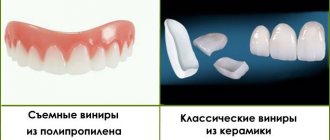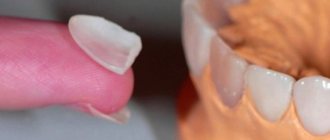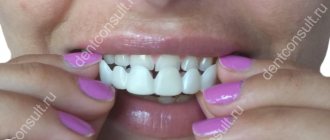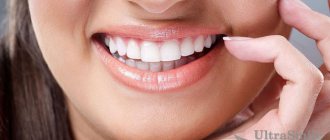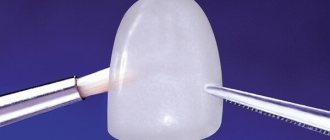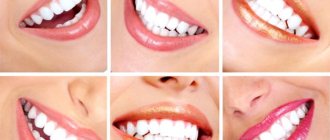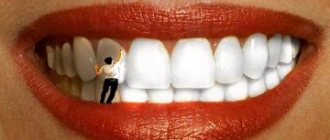Dental onlays are orthopedic mini-prostheses used to restore the aesthetics of the dentition. Dental restoration is usually carried out:
- for medical reasons (treatment, prevention of dental diseases, reconstruction of lost teeth);
- in order to restore the aesthetics of a smile.
To satisfy these needs, there are many ways in which dental restoration with onlays is carried out. In this article we will look at the most popular of them.
What kind of design is this and its features
What kind of dentures are these and how are removable dentures different from all the others? Removable veneers are veneers that can be removed. It would seem nothing complicated. But in this simplicity lies either an advertising ploy - it misleads patients, or such veneers will soon have to be replaced with permanent ones - which in theory they should be.
It is worth saying that not a single self-respecting orthopedic dentist will offer a patient removable “veneers” as an option to improve the aesthetics of a smile. What's the point here? In general, veneers1 are non-removable microprostheses - overlay plates on the upper and lower front teeth, which make them more beautiful in shape and shade. But such onlays are made in a dental laboratory (this is important!) within a few days or weeks. During this time, the patient is given temporary plates - composite or plastic, which will soon be removed. They are needed to protect the ground teeth from damage and temporarily give them a natural look.
Those removable veneers that are offered to patients on websites on the Internet or in advertising videos and booklets are most often similar to conventional silicone dentures for the entire jaw. They also resemble the joke “jaws” that people wear to masquerades, and even chewing gum in the shape of jaws. They attach very poorly to the mouth and, according to patients, they are completely impossible to wear. You can see how “natural and natural” such products look before and after installation - see the photo.
Types of overlays
Onlays are divided into veneers and lumineers; they ideally cover all the defects of the dentition. The thickness of the linings differs. Veneers require minor grinding of the dental plate, while lumineers are fixed without this manipulation. To make onlays, we use exclusive ceramics from Cerinate. When installing them, our specialists use CEREC technology, which allows us to achieve high precision in work.
The choice of one or another type of onlay depends on the specific condition of the dentition and the wishes of the patient. Our specialists carry out computer modeling of your smile, so you can already see the expected result before starting work.
What problems can artistic restoration solve?
– correction of the natural color of teeth;
– change in imperfect or short teeth;
– closing spaces between teeth;
– changing the incorrect position of the tooth;
– hiding a tarnished filling,
– hiding chips and cracks in teeth.
Advantages and disadvantages of artistic restoration
Veneers and lumineers have a number of advantages:
– significantly change the appearance of a smile for the better, making it more attractive;
– give teeth a natural snow-white color;
– create an ideal tooth shape;
– align the even lower edge of the tooth.
The disadvantages of veneers and lumineers include the fact that they require careful use. To protect against damage, mechanical actions on teeth should be avoided.
Types of removable “veneers”
This group includes the following types of structures (although not all of them have the right to be called veneers):
- temporary onlays for teeth: patients wear them for about 2 weeks or more - up to 2 months. During this time, permanent onlays are made in the laboratory from ceramics, zirconium dioxide, and ceramic composite. Moreover, for both temporary and permanent overlays, the rule applies - each tooth has its own individual veneer, made from impressions,
- DenMat's Snap-On Smile Dentures: These are temporary dentures that look like veneers or crowns bonded together. They can be worn over the entire dentition or on a “problem” sector. Snap-On Smile not only improves the aesthetics of a smile, but can replace several missing teeth in a row. They are made individually from impressions sent to the manufacturer’s laboratory in the USA,
- removable “veneers” on teeth, “dental onlays” or “false teeth”, which can be purchased on the Internet, pharmacies or cosmetics stores: they look like a silicone prosthesis for the entire row, or single onlays that are glued at home yourself.
As for the last variety, there is no talk here of any individualized approach or taking casts. These “dentures” have a standard shape and are suitable for a person with perfectly straight teeth. But in any case, they will not stick well and will come off with a little pressure. So with such a “Hollywood smile” you can only smile (but even this is not a fact), but you won’t be able to chew food.
%akc72%
Teeth onlays to correct bite
If the patient has no complaints about the enamel and is only interested in correcting crowded teeth, the doctor may suggest treatment with special mouthguards or aligners. Unlike fixed orthodontic structures, they can be removed during meals and during oral hygiene procedures. They are practically invisible on the teeth, as they are made of transparent material. Due to their tight fit to the dentition, removable onlays promote gradual teeth alignment. The disadvantage of treatment with mouthguards is their limited effect. If you have a complex case, then it is better to opt for aligners, which are as effective as braces.
What materials are they made from?
Overlay removable veneers are made of polymers, silicone, polypropylene, and plastic in light shades. These are inexpensive materials, they are easy to process and can be easily painted in enamel colors. But we must understand that even in professional dentistry such materials are used only on a temporary basis, because they have low performance characteristics. The materials are softer and more fragile than those used for real microprostheses. They also have irregularities and pores on the surface, into which dietary fiber and dyes become clogged.
Advantages and disadvantages
The advantages or benefits, if you can call them that, are that for not very much money you can get a new look for some kind of masquerade or photo shoot. Then there are the disadvantages, which are mentioned by reviews from dentists and people who decide to buy removable dental veneers. The disadvantages of removable dental veneers are as follows:
- poor fixation in the oral cavity,
- the risk of getting into an awkward situation in society,
- not very aesthetic appearance,
- rapid coloring of lining materials with food coloring, tobacco smoke, etc.,
- discomfort when wearing: such pads are made according to a template, so they will be uncomfortable after installation. After all, absolutely every person has their own individual parameters for the shape and inclination of their teeth, their sizes - it is impossible to measure everyone with one “ruler”,
- unpleasant “chemical” smell or taste from materials,
- risk of complications: damaged enamel, pulpitis, injuries to teeth and gums, chemical and thermal burns, allergic reactions to materials, risk of choking on a peeling pad or swallowing remaining adhesive.
“I placed an order in one group and was led by praise and a large audience. And I was very pleased with the price - it was only 500 rubles, to be honest. But on the day I received it, it turns out I was added to the blacklist. And I couldn’t leave my not at all positive review. These turned out to be not veneers at all, but some kind of toys, just to scare children with them. They do not stick to the teeth and fall out constantly. In general, horror!!!"
Marina_99, review from the woman.ru forum
Contraindications to the use of false teeth
Correcting and decorating teeth with onlays or attachments is not suitable for everyone. Dentists do not recommend resorting to such procedures when:
- inflammatory dental diseases accompanied by bleeding gums;
- diseases of the nervous system;
- allergic reaction to the materials used;
- the presence of bad habits - a tendency to grind teeth, chew hard objects and lack of proper hygiene skills.
How to use removable veneers
How to install and remove removable “veneers” will depend on their type. If the product is in the shape of a full jaw, then they are simply put on the teeth from above and removed from them by hand. Some sellers write that you first need to put the structure in hot water for a few minutes - almost boiling water - and then put it on. But in this case, there is a real risk of burning the gums and overheating the dentinal layer (it is located under the enamel), which can provoke pulpitis. Not to mention the discomfort of the installation process - some people report that it is painful or too hot for the teeth.
Removable “veneers”, which imitate real ones in their shape (but are sold in packs of 70 pieces, and are not made individually), are supposed to be fixed with a special adhesive using a brush and tweezers. And all this on your own at home. But if dentists use only professional formulations with proven components, then it is completely unknown what will end up in the package with “veneers”. It will be good if it is harmless glue (even if it comes off quickly). And if you come across a toxic substance that is difficult to remove, you will have to urgently seek medical help.
Perfect Smile overlay veneers
By removable veneers, dentists mean temporary overlays that protect the patient’s teeth from external influences for that period of time until permanent ones are made. However, today on the Internet you can find offers from various online stores in which users are told about the advantages of inexpensive overlay veneers. For example, Perfect Smile from the USA. Manufacturers claim that this miracle product allows you to achieve an ideal snow-white smile for a while and does not require you to make any sacrifices at all, i.e. allow you to do without grinding the enamel.
But let’s look at their main advantages from the manufacturer’s point of view, and then the disadvantages from the point of view of deceived buyers who have already fallen for the tricks of marketers advertising this product and many beautiful pictures. We will also find out the opinion of professional dentists on this matter.
The manufacturer claims that such devices are universal and are suitable for absolutely all people who need to look irresistible at some event (wedding, business meeting, photo and video shooting). The essence of this method is simple: temporary products are put on the teeth like a mouthguard, and are held securely due to the chemical properties of the material.
To use these veneers, you need to heat them in boiling water for a few minutes, then remove them using a clean cutlery, let them cool slightly and place them tightly on the upper or lower teeth. This is done so that the inside of the veneers adapts to the individual structure of the dentition. After which the pad is removed and placed in a glass of cold water. After the outer side of the veneers turns snow-white, they are placed on the teeth and worn.
Important! Although temptingly cheap, such overlay plates have several significant drawbacks. For example, they do not have an individual design, they do not take into account the structure of the oral cavity, which means they may be uncomfortable to wear. Besides, they look unnatural. In addition, they have to be removed before each meal, otherwise they quickly become unusable.
It would seem that in the head of someone who is going to buy overlays, an ideal image is created. However, in reality everything turns out to be not so beautiful. Plastic or propylene products that people received by mail, after placing them in boiling water, immediately stuck to their teeth, but as soon as they cooled down, they instantly fell off, i.e. They don't stay in the mouth at all. Users also note that they have an unpleasant taste and smell of plastic, like any cheap Chinese product. Plus, the onlays did not fit the size of the teeth, because, of course, they are templates, and at the same time they are not made in a jewelry manner.
Dentists and orthopedists are of the same opinion: if you want to solve dental problems, go to a professional doctor, and do not buy masquerade toys that have a dubious composition. Not only will they not make your smile attractive, but they can also negatively affect your health, because no one rules out the toxicity of the material from which these products are made. In addition, you need to use common sense and understand that pads that are fixed to the water are nonsense.
What is better to choose?
If you understand the question of which removable “veneers” are better, then the only option would be Snap-On Smile dentures. They are made individually and from quality materials. But, since the plant is located in the USA, the patient will have to wait about 1-2 months, and the main waiting time will be spent on transportation. Again, you will have to first visit an orthopedist to take impressions and sanitize the oral cavity. As a result, the final cost of treatment can be close to installing real veneers.
South Korean implant Osstem - from 35,000 rubles.
Hurry up to sign up for a free consultation and lock in promotional prices.
Call now or request a call
Opening hours: 24 hours a day - seven days a week
How much does a “Hollywood” smile cost?
How much do removable dental veneers cost? If you study the offers on various sites, the average price will be 1,200 rubles for a complete “transformation” of your smile. But, as practice and reviews of people who have decided to make such a change in appearance show, this is money down the drain. In reality, such products will not make your smile more beautiful, and they are impossible to wear.
If the patient is interested in the cost of temporary veneers, which need to be worn while the permanent ones are being made, then their cost, as a rule, is already included in the overall price tag. Those. there will be no additional costs. Classic non-removable ceramic onlays for teeth cost from 15 thousand rubles and more - it all depends on the cost of materials and methods of processing them. By the way, if necessary, the doctor will be able to remove them and install new ones if the need arises.
1Gurel G. Ceramic veneers, 2007.
Your questions and answers
QUESTION I bought removable veneers online, but I cannot attach them to my teeth. They fall off constantly. Tell me how to do this better? Alexandra
ANSWER Hello, Alexandra. Unfortunately, there is nothing we can do here. Because these are not veneers at all, but their imitation. Real veneers are installed in dentistry using a special adhesive composition - and remain on it for years. Also, real veneers are made based on impressions of the patient’s dentition, i.e. they are individual and precisely adjusted to the parameters of a particular person. Whereas “veneers from the Internet” are template overlays made according to standards known only to the manufacturers themselves. That's why they don't stick to the teeth. The use of any independently selected adhesives is unacceptable, as this can only harm yourself. Therefore, we do not recommend wearing these products. But you can use them for creativity, crafts - whatever your imagination allows.
White teeth whitening pads
If the goal is only to change the shade of the enamel, dentistry uses the thinnest white overlays on teeth made of composite, as well as in the form of lumineers and ultraneers. Teeth whitening with onlays in this way is suitable only for those who have healthy enamel (or is slightly damaged). The lightening procedure itself using such plates is called restoration bleaching. It is used when traditional types of whitening, such as home, laser, oxygen and Zoom whitening, do not work. During installation, the onlays are attached to the facial surface of the front teeth. Whitening plates are not installed on chewing teeth.
If desired, the patient can always contact the doctor with a request to change the plates to new ones (of a different color) or remove them completely. Moreover, the cost of installing such onlays on teeth will be significantly lower compared to other types of restoration.
